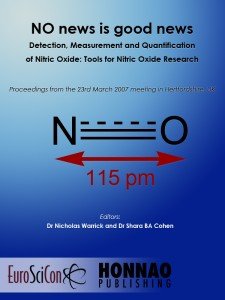Proceedings from the 23rd March 2007 meeting in Hertfordshire, UK
“Nitric oxide (NO), generated by the enzyme nitric oxide synthase (NOS) plays a key role in a diverse range of physiological and pathophysiological conditions within the cardiovascular, immune, reproductive and nervous systems. Since NO is a small, diffusible, highly reactive free radical with a short half-life, and is present in low concentrations, real-time detection of NO is extremely difficult. This meeting will examine methods used to detect and visualise NO-producing cells. Furthermore, direct and indirect techniques used to measure NO will be examined, including among others, the measurement of NOS enzymatic activity, electron paramagnetic resonance (EPR) and NO-sensitive electrodes. Finally, tools that facilitate NO research, such as NOS inhibitors will be examined”. Meeting’s Chair: Dr Nicholas Warrick – University of Oxford
Click here to purchase the report on UK Amazon Kindle
Click here to purchase the report on US Amazon Kindle
Table of Contents
Preface
Contents
Introduction
- NITRIC OXIDE
- NITRIC OXIDE SYNTHASE
- ACTIONS OF NITRIC OXIDE
- MEETING OUTLINE
- REFERENCES
ORAL PRESENTATIONS
Quantification of Blood and Tissue NO Metabolites by Gas Phase Chemiluminescence: a Guide to NO Man’s Land
- Introduction
- Vascular Nitric Oxide Metabolism
- Methods for Metabolite Measurement
- Principle of Chemiluminescence
- Methods of Sample Preparation
- Controversy
- Practicalities
- Concluding Remarks
- References
Radiochemical HPLC measurement of nitric oxide synthesis (NOS) activity in vascular tissue
EPR-based measurement of reactive nitrogen intermediates in human inflammatory diseases
Nitric oxide sensors and their biomedical applications
Understanding NO synthase inhibition; potency, selectivity and implications for their pharmacology
- References
Endogenously occurring inhibitors of nitric oxide synthase
- Abstract
- Methylated arginines as NOS inhibitors
- Measuring ADMA
- Conditions in which ADMA is elevated
- Arginine methylation
- Regulation of ADMA
- Could ADMA be causative in cardiovascular pathologies?
Evaluating endothelial function in humans: From bench to bedside
Nitric oxide synthase inhibition and renal injury
- References
Quantification of enzyme independent stores of nitric oxide in human skin
- References
POSTER PRESENTATIONS
NO quantification in abnormal and manipulated red blood cells
- References
Application of NO detection using Fe(DETC) spin trap and ESR spectroscopy in pharmacological research
- Halogenated volatile anestherics (HVA)
- Flavonoids. Baicalein and luteolin
- TO-85 and TO-133
- Mildronate
- References
Hypoxia-induced regulation of nitric oxide synthase in cardiac endothelial cells and myocytes
- Methods
- Results
- Conclusions
Nitrite regulation of energy expenditure in man
Nitric oxide inhibits cellular lipid and protein synthesis without energy depletion: a process of chronic diseases due to nitrosothiols
NOx concentrations in human brain extracellular fluid and their relationship with energy metabolism: a pilot microdialysis study in acute brain injury
- Background and aims
- Patients and methods
- Results
















Follow Us!